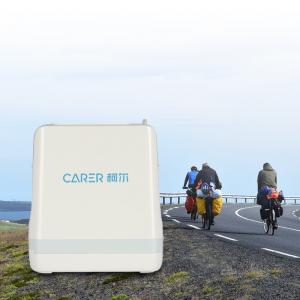
Add to Cart
Smart Continuous Pulse Flow 1-5 Gear Medical Portable Oxygen Concentrator With 93+/-3% Purity For Lung Cancer Patients
Product Parameter
| Product Model | MO-5A |
| Purity | ≥90%(1st-5th gear) |
| Oxygen Flow Rate | Pulse 1st-5th gear(0.2-1L/min) constant frequency 6th gear(1.7L/min |
| Charging Voltage | AC 220V |
| Average Power | 55 VA (W) |
| Charging Duration | 2 hours |
| Battery life | 1.5-4.5 hours (different power from gears 1-6) |
| Operating Altitude | 0-5000M(0-16404ft) |
| Operation Sound | ≦ 60 dB |
| Service Environment | Temperature:-10 - 40℃; Humidity: Under 30 - 75% RH(No condensation) |
| Product size | (W)183 x (D)86x (H)199mm |
| Package Dimension | (W)318 x (D)295x (H)228mm |
| Net Weight | 1.98kgs(4.36lbs) |
| Gross Weight | 3kg |
| Characteristic | Compact body absorbs oxygen anytime and anywhere; Long life high efficiency lithium molecular sieve; LED Screen, more accurate and convenient; Low decibel operation, quiet oxygen. |
| Certificate | Declaration of Conformity |
| Warranty period | 1 years for whole macnine; 3 years for Air Compressor; Lifelong maintenance. |









What Is a Portable Oxygen Concentrator?
Portable oxygen concentrators are battery-operated devices that provide supplemental oxygen to people who “require greater oxygen concentrations than the levels of ambient air,” says Sanul Corrielus, M.D., a board-certified cardiologist based in Philadelphia. “Oxygen concentrators draw oxygen from your immediate environment,” he adds, meaning they don’t require refillable oxygen canisters or tanks, which makes maintenance and upkeep easy.
A portable oxygen concentrator, sometimes called a POC, is similar to a home oxygen concentrator (OC) but more mobile, says Corrielus. These devices are small enough to carry, which makes them ideal for travel, and some are approved for use on airlines.
How an oxygen concentrator works:
The device draws in air from your surrounding environment.
Air is compressed inside the device.
Nitrogen is filtered out of the air.
Pure oxygen is inhaled through a nasal tube (cannula) or mask.
Who need a home oxygen concentrator?
1. Respiratory diseases: pneumonia, bronchitis, chronic bronchitis, viral respiratory tract infection, asthma, emphysema, pulmonary heart disease, etc.
2, cardiovascular and cerebrovascular diseases: hypertension, heart disease, coronary heart disease, myocardial infarction, cerebral thrombosis, cerebral ischemia, cerebral vertigo, atherosclerosis, etc.
3, high altitude hypoxia disease: high altitude pulmonary edema, acute mountain disease, chronic mountain disease, high altitude coma, high altitude hypoxia, etc.
4. People prone to hypoxia: middle-aged and old people, pregnant women, students engaged in mental work for a long time, employees of companies, cadres of organs; People engaged in underground work or confined space for a long time, people with excessive exercise and fatigue and insufficient oxygen supply, etc.
5, other people who need oxygen therapy: people with weak and sickly body and poor immunity, heatstroke, gas poisoning, drug poisoning, etc.